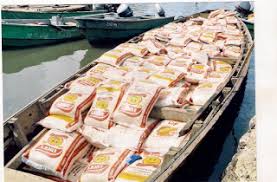Oil & Energy
STRYDE To Deploy Seismic Receiver Nodes Onshore Nigeria
Seismic acquisition technology and solutions provider, STRYDE, has been awarded a contract worth over $1 million for the supply of 10,000 seismic receiver nodes and its “Nimble” node receiver system for an onshore oil and gas project in Nigeria.
STRYDE’s seismic sensor technology will be utilised on an upcoming 3D seismic survey conducted by Nigerian geoscience solutions provider, ATO Geophysical Limited, as part of an onshore oil and gas exploration project in Nigeria.
The seismic survey is due to begin in Q2 2023 and will be the first commercial deployment of STRYDE’s Nimble System in the country as it continues its international expansion within the energy sector.
STRYDE, who are the creators of the world’s smallest and lightest seismic node, will enable ATO to deliver high-density seismic data for the exploration of new reservoir locations in the grasslands and marshlands of Nigeria, for a local oil and gas operator.
Until recently, the country has typically relied on bulky, expensive, and complex cabled geophone receiver systems to acquire seismic data, which traditionally incurs significantly high CAPEX and OPEX costs, more exposure to HSE risk, higher technical downtime, and inefficiencies in the seismic acquisition programme.
With the introduction of cable-less receiver technology like STRYDE’s miniature sensor, geophysical providers and operators can now acquire high-quality data much more efficiently and with less cost, risk, and environmental footprint.
The supply of its node management solution will enable further efficiencies on the survey to be unlocked by allowing ATO to rotate up to 2,160 nodes per day, enabled by the system’s unique capability to simultaneously charge and harvest data from 360 nodes in under four hours.
This system is also equipped with STRYDE’s state-of-the-art software for efficient seismic survey field operations, data harvesting, and quality assurance, allowing ATO to produce processing-ready seismic data fast than ever before.
Head of Business Development, MENA, at STRYDE, Sam Moharir, commented on the transition to nodal technology: “ATO Geophysical Limited needed to have access to cost-effective technology that could also overcome challenges associated with the terrain they were due to operate in’’.
“With cabled systems traditionally being more physically challenging to deploy in remote, large, and complex terrain, STRYDE Nodes™ offer a more efficient and practical solution for improving seismic survey efficiencies through the elimination of restrictive and heavy cabled geophones”.
The Managing Director of ATO Geophysical Limited, Thomas Ajewole, said: “As a leading seismic data acquisition expert in Nigeria, we look forward to partnering on our first project with STRYDE and capitalizing on the benefits of its technology by providing our customers with a more efficient and cost-effective solution to onshore seismic data acquisition.
“As we continue to support the exploration of new oil and gas projects in the region, STRYDE Nodes present an exciting opportunity to acquire high-resolution seismic data required to image the subsurface and pinpoint new reservoir development opportunities for our customers”.
STRYDE’s CEO, Mike Popham, said: “STRYDE is excited to be enabling our first seismic surveys in Nigeria with ATO. This builds upon our successful history of seismic projects across Africa, including Zimbabwe, Namibia, and Kenya.
“We’re proud to see our nodes increasingly being utilized around the world for a range of industrial applications, replacing expensive, cumbersome, and impractical alternative systems with our dynamic technology”.
In addition to providing seismic solutions in the oil and gas market, STRYDE also supports new energy industries including Geothermal, CCUS, Hydrogen, and Mining, providing an affordable solution to a typically expensive phase of any exploration project.
Oil & Energy
FG Woos IOCs On Energy Growth
The Federal Government has expressed optimism in attracting more investments by International Oil Companies (IOCs) into Nigeria to foster growth and sustainability in the energy sector.
This is as some IOCs, particularly Shell and TotalEnergies, had announced plans to divest some of their assets from the country.
Recall that Shell in January, 2024 had said it would sell the Shell Petroleum Development Company of Nigeria Limited (SPDC) to Renaissance.
According to the Minister of State for Petroleum Resources (Oil), Heineken Lokpobiri, increasing investments by IOCs as well as boosting crude production to enhancing Nigeria’s position as a leading player in the global energy market, are the key objectives of the Government.
Lokpobiri emphasized the Ministry’s willingness to collaborate with State Governments, particularly Bayelsa State, in advancing energy sector transformation efforts.
The Minister, who stressed the importance of cooperation in achieving shared goals said, “we are open to partnerships with Bayelsa State Government for mutual progress”.
In response to Governor Douye Diri’s appeal for Ministry intervention in restoring the Atala Oil Field belonging to Bayelsa State, the Minister assured prompt attention to the matter.
He said, “We will look into the issue promptly and ensure fairness and equity in addressing state concerns”.
Lokpobiri explained that the Bayelsa State Governor, Douyi Diri’s visit reaffirmed the commitment of both the Federal and State Government’s readiness to work together towards a sustainable, inclusive, and prosperous energy future for Nigeria.
While speaking, Governor Diri commended the Minister for his remarkable performance in revitalisng the nation’s energy sector.
Oil & Energy
Your Investment Is Safe, FG Tells Investors In Gas
The Federal Government has assured investors in the nation’s gas sector of the security and safety of their investments.
Minister of State for Petroleum Resources (Gas), Ekperikpe Ekpo, gave the assurance while hosting top officials of Shanghai Huayi Energy Chemical Company Group of China (HUAYI) and China Road and Bridge Corporation, who are strategic investors in Brass Methanol and Gas Hub Project in Bayelsa State.
The Minister in a statement stressed that Nigeria was open for investments and investors, insisting that present and prospective foreign investors have no need to entertain fear on the safety of their investment.
Describing the Brass project as one critical project of the President Bola Tinubu-led administration, Ekpo said.
“The Federal Government is committed to developing Nigeria’s gas reserves through projects such as the Brass Methanol project, which presents an opportunity for the diversification of Nigeria’s economy.
“It is for this and other reasons that the project has been accorded the significant concessions (or support) that it enjoys from the government.
“Let me, therefore, assure you of the strong commitment of our government to the security and safety of yours and other investments as we have continually done for similar Chinese investments in Nigeria through the years”, he added.
Ekpo further tasked investors and contractors working on the project to double their efforts, saying, “I want to see this project running for the good of Nigeria and its investors”.
Earlier in his speech, Leader of the Chinese delegation, Mr Zheng Bi Jun, said the visit to the country was to carry out feasibility studies for investments in methanol projects.
On his part, the Managing Director of Brass Fertiliser and Petrochemical Ltd, Mr Ben Okoye, expressed optimism in partnering with genuine investors on the project.
Oil & Energy
Oil Prices Record Second Monthly Gain
Crude oil prices recently logged their second monthly gain in a row as OPEC+ extended their supply curb deal until the end of Q2 2024.
The gains have been considerable, with WTI adding about $7 per barrel over the month of February.
Yet a lot of analysts remain bearish about the commodity’s prospects. In fact, they believe that there is enough oil supply globally to keep Brent around $81 this year and WTI at some $76.50, according to a Reuters poll.
Yet, like last year in U.S. shale showed, there is always the possibility of a major surprise.
According to the respondents in that poll, what’s keeping prices tame is, first, the fact that the Red Sea crisis has not yet affected oil shipments in the region, thanks to alternative routes.
The second reason cited by the analysts is OPEC+ spare capacity, which has increased, thanks to the cuts.
“Spare capacity has reached a multi-year high, which will keep overall market sentiment under pressure over the coming months”, senior analyst, Florian Grunberger, told Reuters.
The perception of ample spare capacity is definitely one factor keeping traders and analysts bearish as they assume this capacity would be put into operation as soon as the market needs it. This may well be an incorrect assumption.
Saudi Arabia and OPEC have given multiple signs that they would only release more production if prices are to their liking, and if cuts are getting extended, then current prices are not to OPEC’s liking yet.
There is more, too. The Saudis, which are cutting the most and have the greatest spare capacity at around 3 million barrels daily right now, are acutely aware that the moment they release additional supply, prices will plunge.
Therefore, the chance of Saudi cuts being reversed anytime soon is pretty slim.
Then there is the U.S. oil production factor. Last year, analysts expected modest output additions from the shale patch because the rig count remained consistently lower than what it was during the strongest shale boom years.
That assumption proved wrong as drillers made substantial gains in well productivity that pushed total production to yet another record.
Perhaps a bit oddly, analysts are once again making a bold assumption for this year: that the productivity gains will continue at the same rate this year as well.
The Energy Information Administration disagrees. In its latest Short-Term Energy Outlook, the authority estimated that U.S. oil output had reached a record high of 13.3 million barrels daily that in January fell to 12.6 million bpd due to harsh winter weather.
For the rest of the year, however, the EIA has forecast a production level remaining around the December record, which will only be broken in February 2025.
Oil demand, meanwhile, will be growing. Wood Mackenzie recently predicted 2024 demand growth at 1.9 million barrels daily.
OPEC sees this year’s demand growth at 2.25 million barrels daily. The IEA is, as usual, the most modest in its expectations, seeing 2024 demand for oil grow by 1.2 million bpd.
With OPEC+ keeping a lid on production and U.S. production remaining largely flat on 2023, if the EIA is correct, a tightening of the supply situation is only a matter of time. Indeed, some are predicting that already.
Natural resource-focused investors Goehring and Rozencwajg recently released their latest market outlook, in which they warned that the oil market may already be in a structural deficit, to manifest later this year.
They also noted a change in the methodology that the EIA uses to estimate oil production, which may well have led to a serious overestimation of production growth.
The discrepancy between actual and reported production, Goehring and Rozencwajg said, could be so significant that the EIA may be estimating growth where there’s a production decline.
So, on the one hand, some pretty important assumptions are being made about demand, namely, that it will grow more slowly this year than it did last year.
This assumption is based on another one, by the way, and this is the assumption that EV sales will rise as strongly as they did last year, when they failed to make a dent in oil demand growth, and kill some oil demand.
On the other hand, there is the assumption that U.S. drillers will keep drilling like they did last year. What would motivate such a development is unclear, besides the expectation that Europe will take in even more U.S. crude this year than it already is.
This is a much safer assumption than the one about demand, by the way. And yet, there are indications from the U.S. oil industry that there will be no pumping at will this year. There will be more production discipline.
Predicting oil prices accurately, even over the shortest of periods, is as safe as flipping a coin. With the number of variables at play at any moment, accurate predictions are usually little more than a fluke, especially when perceptions play such an outsized role in price movements.
One thing is for sure, though. There may be surprises this year in oil.
lrina Slav
Slav writes for Oilprice.com.
-

 News2 days ago
News2 days agoOpobo/Nkoro Administrator Pledges To Prioritise Workers’ Welfare
-

 Maritime1 day ago
Maritime1 day agoTruckers Raise Alarm Over NPA’s Call-Up System
-
Niger Delta2 days ago
A’Ibom LG Chairmen Have No Reason For Failure – Gov
-

 Editorial2 days ago
Editorial2 days agoEaster: A Call For National Renewal
-

 News2 days ago
News2 days agoEaster: End Hardship, Insecurity In Nigeria, Kukah Begs Tinubu
-

 Politics2 days ago
Politics2 days agoPresidency Tackles Baba-Ahmed Over Anti-Tinubu Comments
-

 News2 days ago
News2 days agoRIFF Showcases Creativity, Innovation In Film Industry
-

 Maritime1 day ago
Maritime1 day agoRice Smuggling Still Increasing In Creeks – RMIDN

